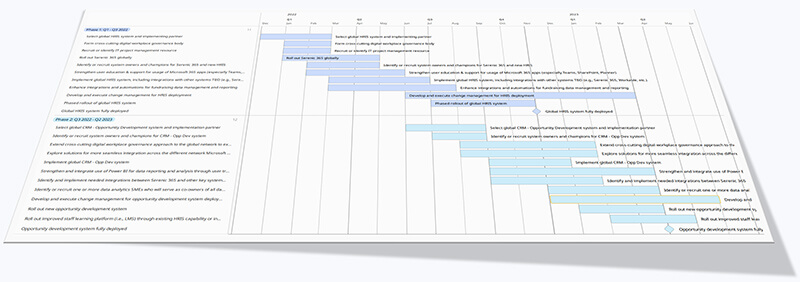A digital transformation roadmap is a guiding document that contains the tactics for achieving your organization's digital transformation strategy. It outlines exactly how and in what timeframe the organization will address key challenges and opportunities across the domains of people, process, and technology.
The digital transformation roadmap provides strategic direction at every project stage, from initial stakeholder buy-in all the way to measuring success.
Read on for a description of the key components of the roadmap and how it can be used effectively throughout your digital transformation journey.
Contents of the Digital Transformation Roadmap
Your roadmap should include the following:
IT Systems Inventory: a list of all business-critical IT systems, their current use, and where they are in their lifecycle (e.g., planned, active, end-of-life, etc.).
Challenges: What are the challenges that the effort will set out to address and where do they sit in order of priority based on urgency and level of difficulty?
Opportunities: What organizational changes and needs are on the horizon or already underway? Are there opportunities where the right kind of digital transformation could help the organization deliver on its KPIs or other metrics of success?
Digital Transformation Objectives: As you synthesize your discovery findings and strategy discussions you'll want to sum up the work to be done with a handful of broad objectives. Examples include "making best use of existing technology" and "clarifying ownership and accountability of key systems". These will set the stage for the work planning and phasing that will comprise the core of your roadmap.

Phased High-Level Work Plan: Starting with your objectives, define key milestones and activities that will move you closer to achieving your stated goals. These activities and milestones should cut across people, processes, and technology. This is critical since even in cases where new technology is being introduced, thoughtfulness around business processes and resourcing will determine the effort's ultimate success or failure. We recommend building out 2-3 phases initially covering 12-24 months, depending on how quickly progress can be made. Other nice-to-have items can be considered in a separate roadmap backlog section.
How a Digital Transformation Roadmap Adds Value At Every Stage
A digital transformation roadmap is a living document that can serve as an essential resource during project planning, start-up, and even months or years after project completion. Here are some key benefits at every project stage.
Planning
The roadmap is a communication tool that can be used to secure stakeholder buy-in for the envisioned digital transformation project. It can also be a helpful change management tool, helping leadership and staff understand and meaningfully support the vision for what success will look like.
If your organization has had unsuccessful change initiatives in the past, the roadmap can reassure staff that there is a master plan in place that will address their needs and pain points in due time. And when people begin getting impatient about improvements taking longer than they had hoped, the roadmap can demonstrate the value of a phased approach that generates incremental but measurable improvements at every step.
Technology Implementation
By outlining a critical path to success from the start, you can prioritize key activities, deliver value as you go, and prioritize digital investments with the greatest ROI for your organization.
As you go about selecting any needed technology, refer to the roadmap to help you focus on user needs and existing challenges. Remember, each element of the digital workplace works together to create an integrated, balanced whole. Instead of chasing the most cutting-edge solution or being swayed by a salesperson's compelling pitch, consider how the new addition will fit into the roadmap and be compatible with other planned changes and system introductions.
Post-Launch
Whatever launch signifies in the context of your project, rest assured that you have now opened the floodgates for the organization to think even bigger about how it can derive the most value from its technology. The roadmap will be your metric of success but will also provide a useful framework for planning subsequent phases of improvement.
The roadmap can also help to enforce a certain discipline and process around how technology decisions are made. Does Department X want to acquire a new system to support its business processes? It's not in the current roadmap so we'll have to evaluate based on how complementary this change would be.
If you or others are faced with tough decisions, the roadmap can help you take a measured, strategic approach to the design of your digital workplace and its evolution over time. Like any strategy, it is a useful, highly visible framework for moving the organization forward that will serve you at every stage of the journey.
About Ideal State
Ideal State is a digital transformation consulting and advisory firm founded in 2016. We believe that anyone, from any department, and with any level of technology experience can lead a successful digital transformation project.

